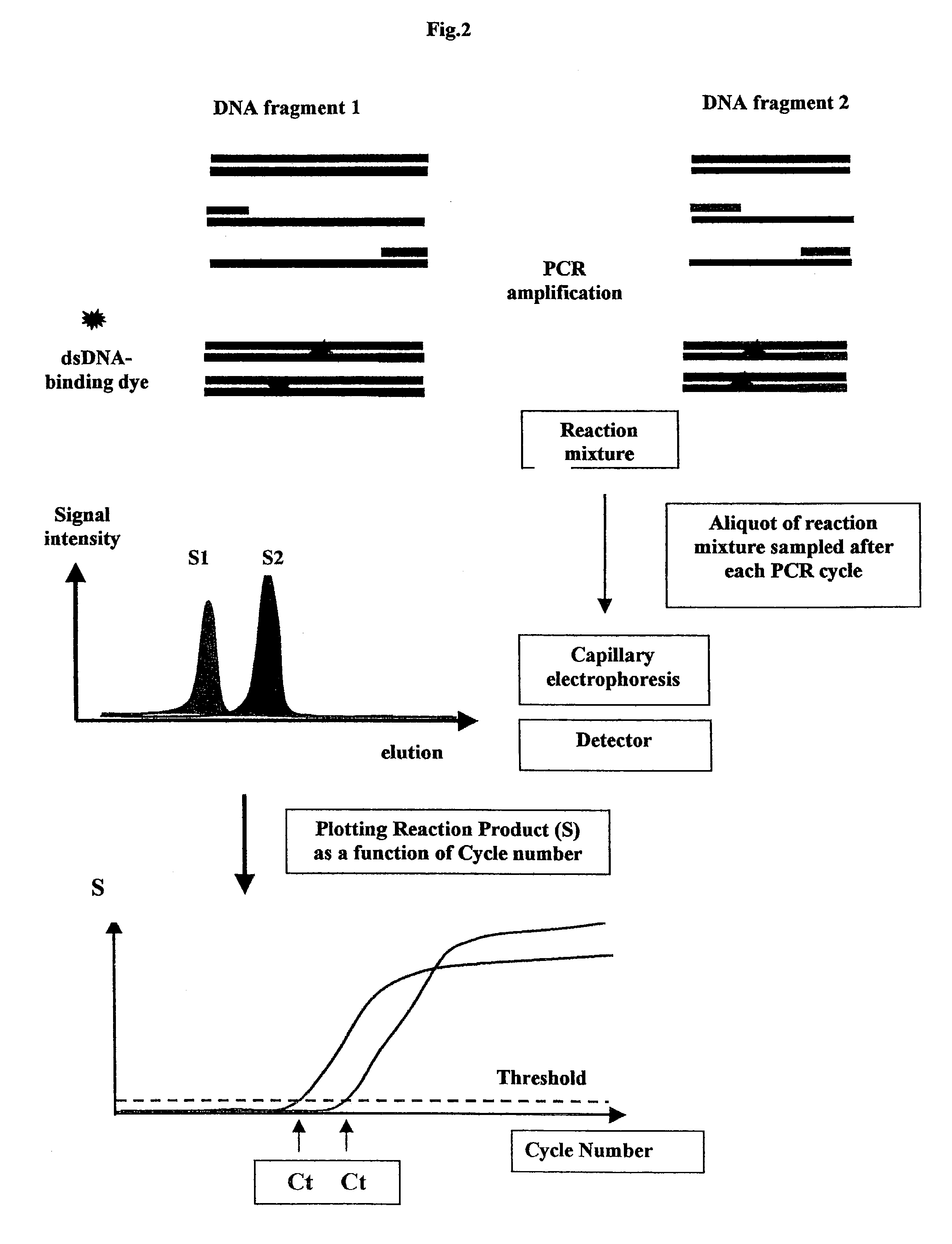Methods for variation detection
a technology of variation detection and detection method, applied in the field of methods for variation detection, can solve the problems of limited ability to “multiplex” (perform analysis of multiple genes in the same amplification reaction) in real-time amplification, and the difficulty of quantitative analysis, so as to improve the determination of abundance
- Summary
- Abstract
- Description
- Claims
- Application Information
AI Technical Summary
Benefits of technology
Problems solved by technology
Method used
Image
Examples
example 1
Quantitative Detection of Multiple Amplicons in a Single Amplification Reaction
[0135]Sample DNA constructs: DNA fragments cloned in pcDNA3 vector (Invitrogen) were amplified in PCR reaction using forward primer (5′-ATCGAAATTAATACGACTCACTAT-3′; SEQ ID NO: 1) and reverse primer (5′-AGCTCTAGCATTTAGGTGACACTA-3′; SEQ ID NO: 2). Amplified DNA fragments were purified by agarose gel electrophoresis and extracted from the gel using a purification kit (Qiagen). Corresponding RNA fragments containing unique sequence tags were prepared using T7 RNA polymerase transcription kit (Invitrogen) and purified by “RNA Easy” RNA purification kit (Qiagen). Concentration of RNA fragments was measured on SmartSpec 3000 spectrophotometer (Bio-Rad).
Preparation of oligonucleotides covalently coupled to solid support: Oligonucleotides TJLF (5′-AATTCCGCGCCGAATAATATTAAGCTCTAGCATTTAG-3′; SEQ ID NO: 3) and (5′-AATTCCCGGCGGATTATTTATTAGCTCTAGCATTTAG-3′; SEQ ID NO: 4) containing sequence tags LFAM 2(5′-CCGCGCCGAATAAT...
example 2
Analysis of Differential Expression Using Known Quantities of Sample RNAs
[0136]Two samples of control RNAs were prepared in nuclease-free water:[0137]sample 1 containing: VS31 RNA 53 pg / ul and VS32 RNA 42 pg / ul[0138]sample 2 containing: VS31 RNA 53 pg / ul and VS32 RNA 102 pg / ul.
3 ul of each sample were mixed with 1.25 ul 20 mM dNTP, 1 ul of 100 uM primer (JLFam (5′-CCGCGCCGAATAATATTAAGCTCTAGCATTTAG-3′; SEQ ID NO: 8) for sample 1 and JLRox1 (5′-CCCGGCGGATTATTTATTAGCTCTAGCATTTAG-3′; SEQ ID NO: 9) for sample 2) and nuclease free water to 10 ul. RNA was denatured for 2 min at 80° C. and cooled on ice. 15 ul of reaction mixture was added and incubated for 1 hour at 42° C.
[0139]RT Reaction Mixture:
[0140]
5X buffer 5 ul0.1 mM DTT2.5 ulSuperscript II RT (200 U / ul)0.5 ul (25 to 100 U depending on quantityof RNA)80% trehalose6.4 ul10 mg / ml BSA0.5 ulSUPERase In (20 U / ul) 1 ul
[0141]Final composition of RT reaction: RNA, 50 mM Tris-HCl, pH 8.3, 75 mM KCl, 3 mM MgCl2, 10 uM DTT, 50U SS II RT, 20%...
PUM
| Property | Measurement | Unit |
|---|---|---|
| Angle | aaaaa | aaaaa |
| Molar density | aaaaa | aaaaa |
| Molar density | aaaaa | aaaaa |
Abstract
Description
Claims
Application Information
 Login to View More
Login to View More - R&D
- Intellectual Property
- Life Sciences
- Materials
- Tech Scout
- Unparalleled Data Quality
- Higher Quality Content
- 60% Fewer Hallucinations
Browse by: Latest US Patents, China's latest patents, Technical Efficacy Thesaurus, Application Domain, Technology Topic, Popular Technical Reports.
© 2025 PatSnap. All rights reserved.Legal|Privacy policy|Modern Slavery Act Transparency Statement|Sitemap|About US| Contact US: help@patsnap.com



